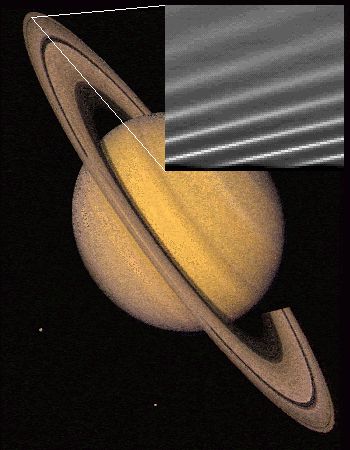

The research which I am currently doing as part of my research
assistantship here at CU is to investigate the damping of
gravitationally induced wakes in rings due to interparticle
collisions. I am doing this work under the supervision of Glen
Stewart. The study of wakes in rings was essentially born with the
voyager flyby of Saturn. Before that time it was generally believed
that the rings of Saturn were rather uniform. Close up images and
ring occultations however, shows that this was definitely not the
case. Instead there were many small details and structures in the
rings. One of these was called the Encke gap. It was a thin region
(approximately 325km across) in which there were no ring particles.
Occultation data from the rings near the Encke gap showed that there
were wakes, where the optical depth of the rings fluctuated in a wave
like pattern that damped out farther from the gap.
By looking at these wakes people were able to determine that they most likely were formed by a small moon that had an orbit in the gap, and that it was due the presence of this moon that the gap itself existed. The moon was actually found on several voyager images and given the name Pan. To some this might sound like it should be the end of the story, but there are still many questions associated with the structure of these wakes.
In 1991 Glen published a paper in Icarus entitled "Nonlinear Satellite Wakes in Planetary Rings." In this paper he did a derivation of the structure of these wakes without collisional dampening using kinetic theory and working in guiding center coordinates. This paper has been the starting block for my own research in which I use Glen's analytic distribution of ring particles as an initial condition and simulate a statistical sampling of ring particles as they move down stream and calculate how they are effected by collisions.
The output from a number of these simulations can be found here.
To date I have developed a code that can find and process collisions for many thousands of particles (I have been using 100,000) on a single processor workstation fast enough to complete the integration of a full synodic period (~550 orbits) in well under a week of run time. There are two main reasons for this, but I can't put too much here yet. I do need to get some type of publication from this work.
Of course, this code only deals with collisions and because of how far from Saturn the Encke gap is located, gravitational interactions between the particles is also important. For this reason the next step in the evolution of this project is to add self-gravity to the simulations. It is quite possible that even if the wakes don't persist through a synodic period with only collisions they will with gravity.
Previous work by Salo has shows that at distances near that of the gap, that particles will form persistent clumps due simply to mutual gravitational attraction. However, the structures that he found are significantly smaller than the wakes caused by Pan though the scale of those structures might have been largely determined by the size of his simulation, as he readily points out.
Back to my Main Page.
ml@colorado.edu